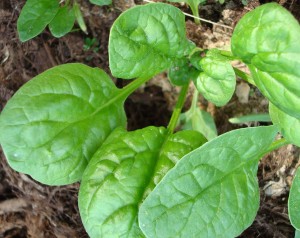Growing Spinach
Soil
Spinach prefers a well draining soil with a neutral pH and won’t be happy in a pH lower than 6.0. Because it is such a fast grower, it is also a heavy feeder. A fertilizer high in nitrogen, the first number on the fertilizer package, will help produce dark, healthy leaves. Fish emulsion and soy meal are good organic choices.
 Planting
Planting
You can start spinach indoors or direct seeded in the garden as soon as the soil is workable. Spinach grows quite quickly, so don’t start plants indoors more than a 2-3 weeks before you plant to transplant them out. Spinach also matures and goes to seed quickly, so it is better to re-seed every couple of weeks than to try and plant a large crop to harvest over time.
Sow the spinach seeds thinly in rows spaced about 1 -1 ½ ft. apart or simply scatter the seeds in blocks. Cover lightly with soil, firm in place and water well. Keep the soil moist until germination. Once the plants have a grown their true leaves, you can begin to thin the plants to about 6″ apart. Of course, you can eat your thinnings.
As the weather warms, spinach plants will bolt more quickly. Expect to stop sowing spinach seeds sometime in May or June, depending on your climate (not in Florida). You can extend the season slightly by planting in the shade of taller plants and keeping your spinach plants regularly watered.
In Florida Fall growing
Spinach also grows well in the cool, short days of fall. Start seeds in September and plant out direct seed in October. I have found this is the only time I can grow spinach here in Florida. You can continue to succession plant until February.
Over-wintering Spinach Plants
You can continue sowing spinach seeds late into the fall season. In warmer climates, you could quite possibly be harvesting well into winter. If the ground freezes before the plants mature, mulch them with hay and leave them be until the temperatures warm again in spring. Remove the mulch and the plants should resume growing, giving you an even earlier harvest.
Growing Spinach in Containers
If space is tight or rabbits are many, you can easily grow spinach in containers. Even a relatively small 10-12″ pot or a window,box will do. Plant as you would in the garden, however you will need to water more frequently, since containers dry out faster.
Exposure Annual/Full Sun / Partial Shade
Days to Harvest
4-6 weeks from seed. You can begin harvesting whenever the leaves are large enough for your taste.
Harvesting Spinach can be harvested in the cut and come again method of harvesting lettuce. Cut individual leaves, starting with the older, outer leaves, and letting the young inner leaves remain and continue growing for a later harvest. You can also cut down the whole plant, for a larger harvest. If you cut about an inch above the crown or base of the plant, it is very likely the plant will send out a new flush of leaves.
Pests and Problems
Because spinach is grown when the weather is cool and damp, several fungus diseases, like downy mildew (blue mold) and fusarium wilt, can become problems. Space your spinach plants so they get good air circulation and try to keep water off the leaves in the evening.
Aphids pose a risk because they can spread viruses. Monitor for aphids regularly and hose them off immediately.
Several 4-legged pest, rabbits chief among them, will also raid your spinach patch.